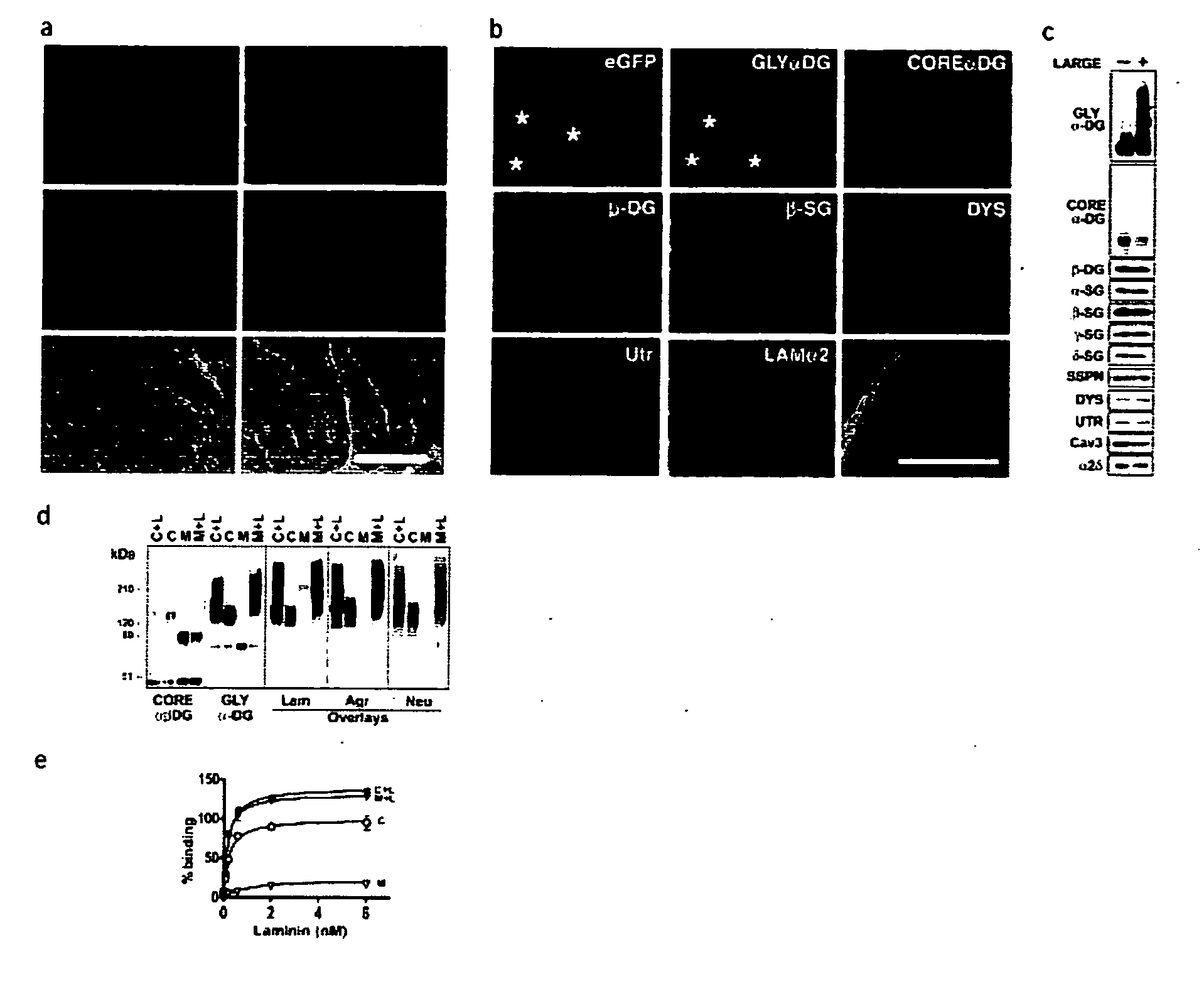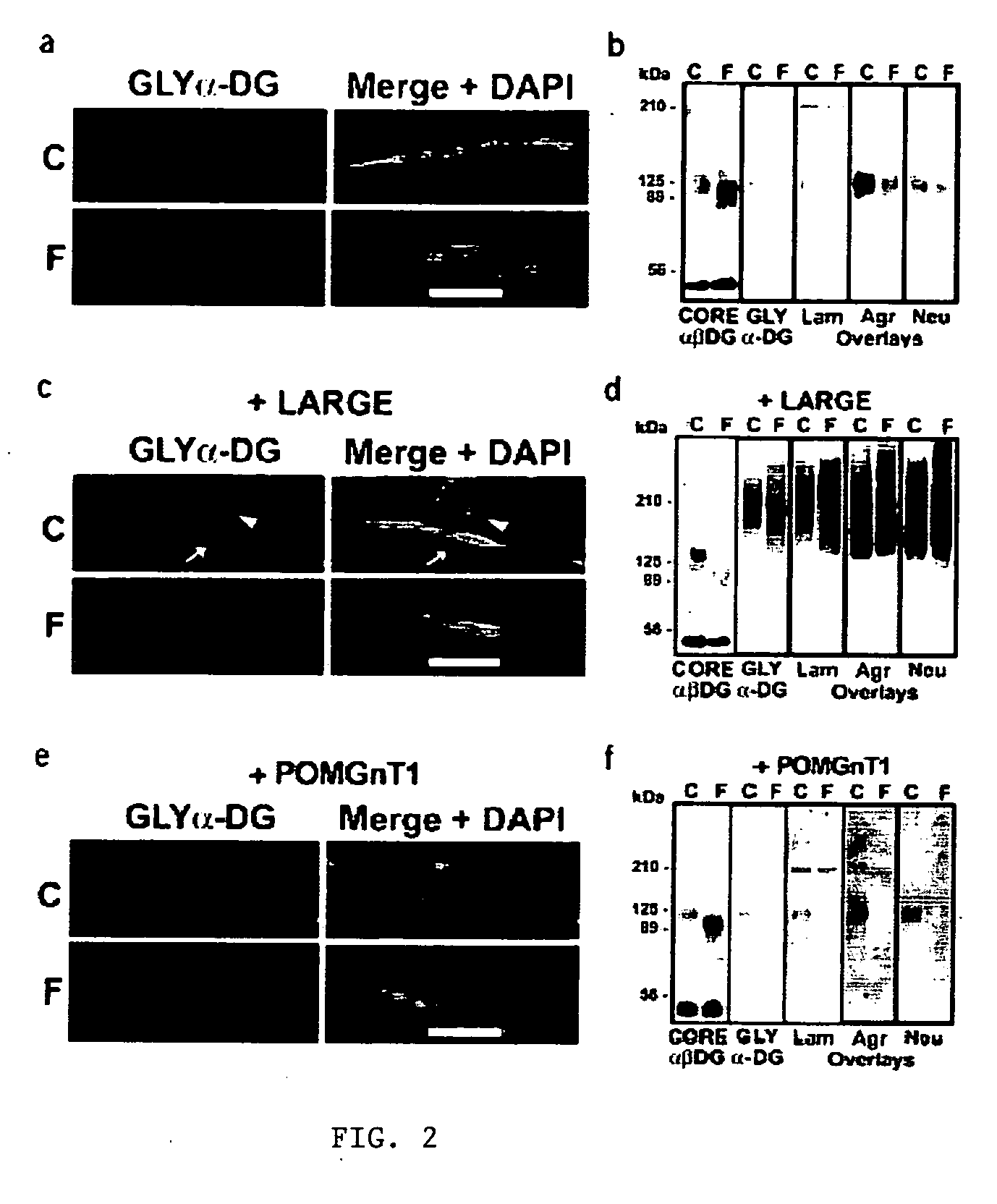Increasing functional glycosylation of alpha-dystroglycan in the treatment of muscle degeneration
a technology of alpha-dystroglycan and functional glycosylation, which is applied in the direction of peptides, drug compositions, peptides, etc., can solve the problems of loss of functional link between, breakage of structural connection between sarcolemma and extracellular matrix, and insufficient anchored -dystroglycan to the muscle plasma membrane, etc., to achieve the effect of preventing or treating muscle degeneration and increasing the functional glycos
- Summary
- Abstract
- Description
- Claims
- Application Information
AI Technical Summary
Benefits of technology
Problems solved by technology
Method used
Image
Examples
example 1
LARGE can Functionally Bypass α-dystroglycan Glycosylation Defects in Distinct Congenital Muscular Dystrophies
Results
[0044] LARGE prevents muscular dystrophy in Largemyd mice. To investigate the effect of LARGE on α-DG glycosylation, we generated an adenovirus expressing LARGE and eGFP (Ad5-LARGE / eGFP). Gene transfer was performed in Largemyd and littermate pups. Injected and non-injected contralateral leg muscles were examined for DG expression using a panel of antibodies to core and glycosylated α-DG. Transduction efficiency estimated by eGFP expression was 40-80% (FIG. 1a). All transduced muscle fibers reacted with antibodies to glycosylated α-DG. Expression of other DGC components did not change (FIG. 1b, and not shown). Dystrophic histological features such as internally placed nuclei were reduced by over 70% in Largemyd transduced muscles and significant reduction in fiber size variation was observed after treatment (P=0.007). Analysis of Largemyd mice treated with Ad5-LARG...
example 2
Molecular Recognition by LARGE is Essential for Expression of Functional Dystroglycan
Results
Post-Translational Modification Regulates Laminin-Receptor Function of DG
[0061] To examine the nature of the α-DG-laminin interactions, we generated a set of adenovirus (AdV)-constructs with deletions in the N-terminal and / or the mucin-like domain of α-DG (FIG. 7A). These deletion constructs, when expressed in embryonic stem (ES) cells, can properly target α- and β-DG proteins to the cell surface membrane (Kunz et al., 2001). First, we performed a laminin-1 and perlecan clustering assay on DG-null (DG− / −) ES cells after infection with each AdV-construct to define the DG domains necessary for DG-mediated basement membrane assembly. Laminin-1 and perlecan formed clusters, which consolidated into plaque-like morphologies, on the surface of ES cells expressing DG-WT or DG-G. No clusters were observed on the cells expressing DG-I, DG-D, DG-E or DG-F (FIG. 7B). Next, the laminin-binding domain...
example 3
Identification of Acceptor Motif for LARGE-Dependent Glycosylation
Results
[0080]α-DG consists of the N-terminal, mucin-like, and C-terminal domains (FIG. 14). The presence of the N-terminal domain is necessary for the functional glycosylation on the mucin-like domain (Kanagawa et al., 2004). Overexpression of LARGE induces hyperglycosylation of α-DG and strongly enhances ligand-binding activities of α-DG (Barresi et al., 2004). Importantly, the LARGE-dependent hyperglycosylation takes place in dystroglycanopathy cells lacking POMT1, POMGnT, and fukutin. Therefore, a novel therapeutic approach using LARGE toward to congenital muscular dystrophies was proposed. In order to determine the LARGE-dependent glycosylation region in the mucin-like domain, we generated various deletion mutants in the mucin-like domain as a fusion protein with Fc. Since the presence of the N-terminal domain is essential for successful glycosylation, all constructs contain the N-terminal domain. The N-termina...
PUM
| Property | Measurement | Unit |
|---|---|---|
| relative molecular mass | aaaaa | aaaaa |
| speed | aaaaa | aaaaa |
| pH | aaaaa | aaaaa |
Abstract
Description
Claims
Application Information
 Login to View More
Login to View More - R&D
- Intellectual Property
- Life Sciences
- Materials
- Tech Scout
- Unparalleled Data Quality
- Higher Quality Content
- 60% Fewer Hallucinations
Browse by: Latest US Patents, China's latest patents, Technical Efficacy Thesaurus, Application Domain, Technology Topic, Popular Technical Reports.
© 2025 PatSnap. All rights reserved.Legal|Privacy policy|Modern Slavery Act Transparency Statement|Sitemap|About US| Contact US: help@patsnap.com



